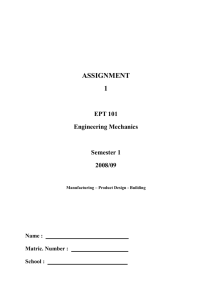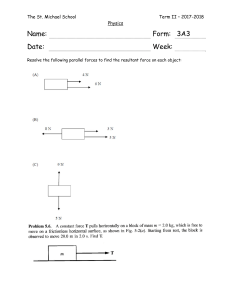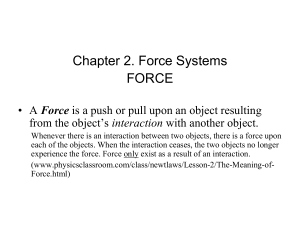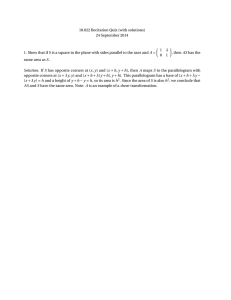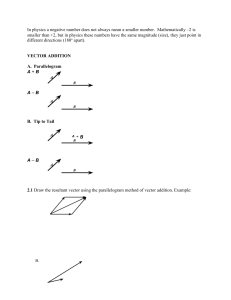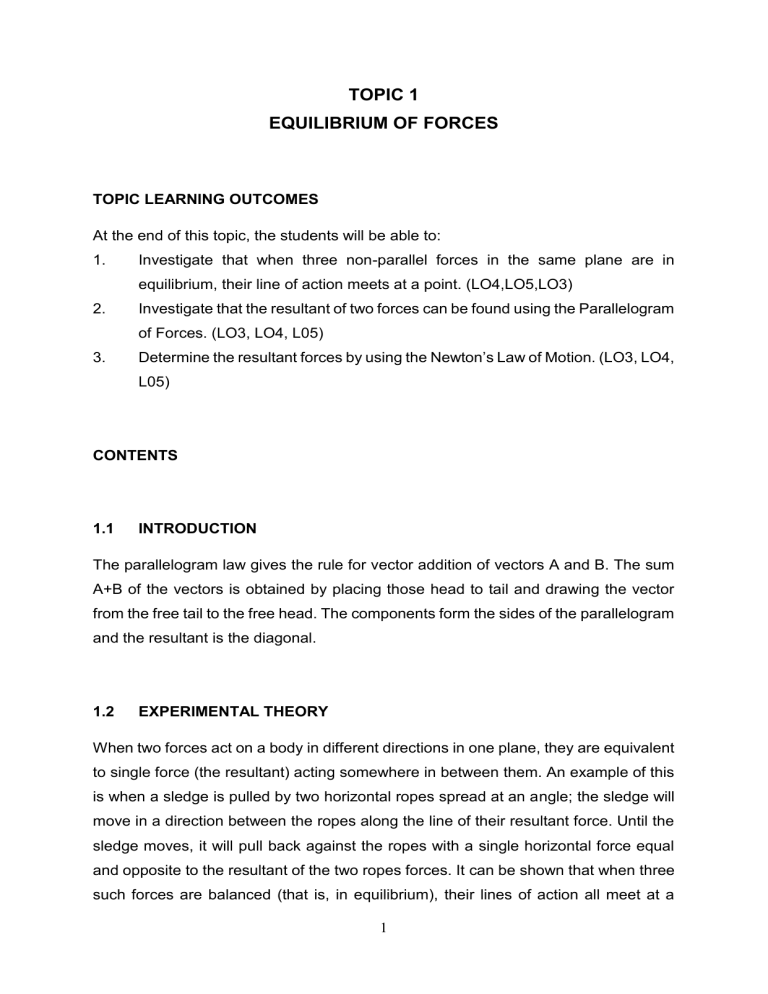
TOPIC 1 EQUILIBRIUM OF FORCES TOPIC LEARNING OUTCOMES At the end of this topic, the students will be able to: 1. Investigate that when three non-parallel forces in the same plane are in equilibrium, their line of action meets at a point. (LO4,LO5,LO3) 2. Investigate that the resultant of two forces can be found using the Parallelogram of Forces. (LO3, LO4, L05) 3. Determine the resultant forces by using the Newton’s Law of Motion. (LO3, LO4, L05) CONTENTS 1.1 INTRODUCTION The parallelogram law gives the rule for vector addition of vectors A and B. The sum A+B of the vectors is obtained by placing those head to tail and drawing the vector from the free tail to the free head. The components form the sides of the parallelogram and the resultant is the diagonal. 1.2 EXPERIMENTAL THEORY When two forces act on a body in different directions in one plane, they are equivalent to single force (the resultant) acting somewhere in between them. An example of this is when a sledge is pulled by two horizontal ropes spread at an angle; the sledge will move in a direction between the ropes along the line of their resultant force. Until the sledge moves, it will pull back against the ropes with a single horizontal force equal and opposite to the resultant of the two ropes forces. It can be shown that when three such forces are balanced (that is, in equilibrium), their lines of action all meet at a 1 point. Using this fact, the resultant of two forces in the same plane at an angle can be found by graphical method called the Parallelogram of Forces. To maintain equilibrium it is necessary and sufficient that the resultant force acting on a rigid body to be equal to zero. In terms of Newton’s laws of motion, this is expressed mathematically as: F 0 ; Where, F is the vector sum of all forces acting on the particle. When the body is subjected to a system of forces which all lie in the x-y plane, the forces can be resolved into their x and y components. Consequently, the conditions for equilibrium in two dimensions can be written in scalar form as: F X 0 and F y 0 Let’s say that there are three forces namely F1 , F2 and F3 acts on a body as shown in Figure 1.1. F2 F1 2 1 F3 Figure 1.1 Free Body Diagram For equilibrium, this equation must be equal to zero. Hence, F1 F2 F3 0 . Therefore, F1 F2 F3 . F x The sum of forces of x components, The sum of forces of y components, 0; F1sinθ1 F2 sinθ 2 0 F1 sinθ 2 F2 sinθ1 F y …(1) 0; F1cosθ1 F2 cosθ 2 F3 0 …(2) 2 1.3 EXPERIMENTAL EQUIPMENTS Table 1.1 Parallelogram of Forces Equipment List No. Apparatus Qty. 1 Diagram board with clips ( P 3 ) 1 2 Short Screws 2 3 Pulleys ( P12) 2 4 Knurled Nuts 4 5 Weight Hooks [0.1N] ( P10) 3 6 Set of Weights 0.05N, 0.1N, 0.5N, 1N, 2N 1 7 Ring with 3 cords attached 1 8 Protractor 1 9 Some sheets of plain paper 1.4 EXPERIMENTAL PROCEDURES 1. Prepare the mounting panel as shown in Figure 1.2. 2. Clip a sheet of paper to the diagram board. 3. Pass two of ring cords over the pulleys. Let the third cord hang directly downwards. 4. Attach all cords by 0.1 N weight hooks. 5. Attach the weight of 2.4N to the weight hook W 3 and the weight of 1.9N to the weight hook W 1 and W2. Write in the weight supported by each cord W1, W2 and W3 (including 0.1N which is the weight of each weight hook) as shown in Figure 1.3. 6. Gently cause the system to bounce by jogging the CENTRE weight only and letting it settle freely in its equilibrium position. 7. Mark the position of the three cords with pencil dots on the paper. 8. Remove the paper and join up the dots representing the three cords. 9. Measure the angle reading of 1 and 2 using protractor. 10. Repeat step 5 and 9 while you adjust the weights of W2 by 0.1N increments until reached 2.5 N. 3 Figure 1.2 Parallelogram of Forces Apparatus Setup 2.0 N 2.0 N 2.3 N 2.0 N 2.5 N 2.5 N Figure 1.3 Experiment Setup 4 1.5 ACTIVITIES 1.5.1 ADDITIONAL THEORY (10%) a. Please describe additional theory according to this topic. 1.5.2 RESULTS (15%) a. Fill in the experimental result in the Table 1.2. b. Fill in the Table 1.3 using calculation method. (Please refer Law of cosines to get the angle) c. Plot the graph of sinθ 2 W1 F1 against for both experimental and calculated sinθ1 W2 F2 results. d. In each of your diagram, the lines representing the cord positions should be meets at the centre of the ring. Along the upper cord lines, mark off lengths OA and OB to represent the pull of weights W1 and W2 (Figure 3). Choose a suitable scale for this, (e.g. 50mm per N). Through A draw a line AC parallel to OB, and through B draw a line BC parallel to OA, to from the parallelogram OACB. Draw in the diagonal OC. This is the resultant force, F of the vector F1 and F2 . e. Measure the length and direction of OC. 1.5.3 OBSERVATIONS (20%) a. Please make observations of the experiment that you have conducted. 1.5.4 CALCULATIONS (10%) a. Shows your calculations. 1.5.5 DISCUSSIONS (15%) a. Discuss the graphs obtained (5%). b. Discuss the parallelogram diagrams obtained (5%). c. Make a comparison between experimental and calculated result (5%). 5 1.5.6 QUESTIONS (10%) a. Explain the parallelogram method to find the resultant of two parallel forces (5%). b. What are the alternative methods that can be used to analyze the addition of two forces (5%). 1.5.7 CONCLUSIONS (15%) a. Deduce conclusions from the experiment. Please comment on your experimental work in terms of achievement, problems faced throughout the experiment and suggest recommendation for improvements 1.5.8 REFERENCES (5%) a. Please list down your references according to APA citation standard 1.6 SUGGESTED REFERENCES 1. Meriam, J.L. And Kraige, L.G., 2007, “Engineering Mechanics: Statics”, 6th S.I. Edition, John Wiley & Sons,Inc. Call number: TA350. M47 2007. 2. Hibbeler, R.C., 2007, “Engineering Mechanics: Statics”, 12th Edition, PrenticeHall International. Call number:TA351. H52 2009. 3. Beer, F.P., Johnston, E.R. And Flori R.E., 2008. “Mechanics for Engineers – Statics”, 5th Edition, McGraw Hill. Call number: TA350. B44 2008. 6 1.7 DATA SHEETS Table 1.2 Experimental Results Weight Angle Angle Ratio No. W3 W1 W2 (N) (N) (N) θ1 θ2 sinθ1 2.0 2.1 2.2 1 2.5 2.0 2.3 2.4 2.5 * Data sheet must approved by the instructor. 7 sinθ 2 sinθ 2 sinθ1 W1 F1 W2 F2 Table 1.3 Calculated Results Weight Angle Angle Ratio No. W3 W1 W2 (N) (N) (N) θ1 θ2 sinθ1 2.0 2.1 2.2 1 2.5 2.0 2.3 2.4 2.5 * Data sheet must approved by the instructor. 8 sinθ 2 sinθ 2 sinθ1 W1 F1 W2 F2
